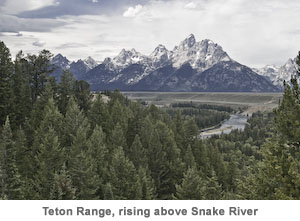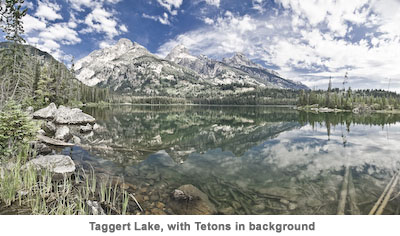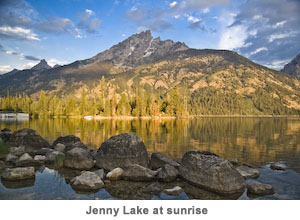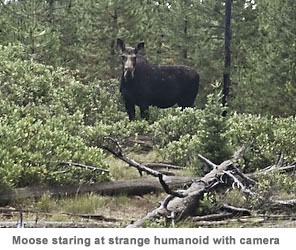Greg Nyquist |
Touring America's Northwest:
Grand Teton National Park
Editor's Note: This article is fifth in a series of travel sketches from America's northwest, including northern California, Nevada, Idaho, Wyoming, Montana, Washington, and Oregon. You can read the previous article in the series, on Idaho, by going here.
There may exist, somewhere in the world, a more stunning individual mountain or peak, as there may exist more stunning mountain scenery, but there is no single mountain range that can equal, let alone surpass, the magnificence of the Teton Range. This chain of lofty granite clad peaks rises nearly 7,000 feet from the surrounding plains on the east side of the range, providing a jagged grayish-purple backdrop against the western horizon of awe-inspiring dimensions.The highest peak in the rage, Grand Teton, its summit reaching the lofty elevation of 13,770 feet in elevation, ascends into the heavens like an immense spire or obelisk. The Tetons are tall, narrow mountains, difficult to climb or scale. Indeed, though there are ever so many trails climbing this canyon or that ravine in the Tetons, no trails lead to the summit of one of the main peaks in the range. How do you make a trail up the side of a granite cliff? To scale a Teton summit requires considerable mountain climbing skills.
This chain of lofty granite clad peaks rises nearly 7,000 feet from the surrounding plains on the east side of the range, providing a jagged grayish-purple backdrop against the western horizon of awe-inspiring dimensions.The highest peak in the rage, Grand Teton, its summit reaching the lofty elevation of 13,770 feet in elevation, ascends into the heavens like an immense spire or obelisk. The Tetons are tall, narrow mountains, difficult to climb or scale. Indeed, though there are ever so many trails climbing this canyon or that ravine in the Tetons, no trails lead to the summit of one of the main peaks in the range. How do you make a trail up the side of a granite cliff? To scale a Teton summit requires considerable mountain climbing skills.
While Grand Teton National Park is — not surprisingly — most famous for its mountain range, just as critical are the many lakes which server as reflecting pools to the granite peaks that rise above them. The largest of the lakes is Jackson Lake, but the most beautiful is Jenny, which spreads its waters right below one of the most scenic sections of the range. There are innumerable smaller lakes as well, which can be reached by hiking a few miles into the mountains. Taggert and Bradley Lakes, nestled a few miles from the trail-head near the base of mighty Grand Teton itself, are two of the most beautiful mountain lakes to be found anywhere.
The largest of the lakes is Jackson Lake, but the most beautiful is Jenny, which spreads its waters right below one of the most scenic sections of the range. There are innumerable smaller lakes as well, which can be reached by hiking a few miles into the mountains. Taggert and Bradley Lakes, nestled a few miles from the trail-head near the base of mighty Grand Teton itself, are two of the most beautiful mountain lakes to be found anywhere.
To enter at Grand Tetons National Park from the south, one almost invariably must pass through the town of Jackson, which, if it weren't so choked with traffic during the tourist season, would be a very nice place, despite the sort of facile faux-western look that it, in many places, aspires to. The town is kept in good repair, with its pleasant trees and well kept yards. The influence of money would seem here to be paramount. Nothing brings down the level of a town such as the social dysfunctional associated with poverty and ne'er-do-wellism, the curse of many run down urban and rural communities.
One of the more curious phenomena which I noticed in my two and a half day stint at the Tetons was the tendency for the park to become more crowded as the day progressed, until reached a sort of climax around two or three o'clock. I describe it as curious not because it is particularly unusual. I've noticed a similar tendency in other national parks. But in the Tetons it seems most inappropriate. Grand Teton National Park is best enjoyed in the morning, particularly the early morning, when the Summer sun, sneaking over the Continental Divide, spreads its golden beams among the granite clad peaks of the Tetons, casting a rich amber backdrop to the pale silver lakes that front the range. By mid-afternoon, the sun has slipped to the other side of the range. Only at sunset — assuming, of course, that atmospheric conditions are just right — can the Tetons once again be viewed to advantage, against a sky fading to crimson as dusk envelops the park. But, strange to say, the evenings are just as destitute of crowds as are the early mornings. Strange it is that people will drive hundreds, even thousands of miles to see the Tetons yet they don't take the trouble to see the range at the very best time for viewing it!
But in the Tetons it seems most inappropriate. Grand Teton National Park is best enjoyed in the morning, particularly the early morning, when the Summer sun, sneaking over the Continental Divide, spreads its golden beams among the granite clad peaks of the Tetons, casting a rich amber backdrop to the pale silver lakes that front the range. By mid-afternoon, the sun has slipped to the other side of the range. Only at sunset — assuming, of course, that atmospheric conditions are just right — can the Tetons once again be viewed to advantage, against a sky fading to crimson as dusk envelops the park. But, strange to say, the evenings are just as destitute of crowds as are the early mornings. Strange it is that people will drive hundreds, even thousands of miles to see the Tetons yet they don't take the trouble to see the range at the very best time for viewing it!
 Besides the mountains and the lakes, the favorite gawking pastime for tourists at the Tetons involves wildlife.Critters here aplenty. Besides the usual assortment of squirrels, mice, badgers, coyotes and beavers, the park is home to bears, pronghorns, ermines, roosevelt elk, moose, wolves, bald eagles, pelicans, and mountain lions. Most of the animals are content to leave the human critters alone. But not the bears. I am speaking here of black bears, not the grizzlies, which rarely venture this far south. Except for the size of the critter, there is little to differentiate the black bear from your common rodent. That, as I have stated elsewhere, is the truth of the matter. Most incredible, even dangerous nuisances, are these animals!
Besides the mountains and the lakes, the favorite gawking pastime for tourists at the Tetons involves wildlife.Critters here aplenty. Besides the usual assortment of squirrels, mice, badgers, coyotes and beavers, the park is home to bears, pronghorns, ermines, roosevelt elk, moose, wolves, bald eagles, pelicans, and mountain lions. Most of the animals are content to leave the human critters alone. But not the bears. I am speaking here of black bears, not the grizzlies, which rarely venture this far south. Except for the size of the critter, there is little to differentiate the black bear from your common rodent. That, as I have stated elsewhere, is the truth of the matter. Most incredible, even dangerous nuisances, are these animals!
Bears, whether of the black or brown (i.e., grizzly) variety, are the laziest of animals, a few humanoid rifraff of the scoundrel-species alone excepted. They want to have it as easy as possible, do these lumbering bruins. So they scrounge around garbage cans like hobos, looking for discarded foodstuffs. Easier than picking berries or actually chasing something and killing it! Hunting is not the bear-way. It's far too strenuous for the self-respecting bruin. Bad form for a bear to exterting himself too much! Much better simply to stumble upon one's repast, say in trash bin or in a camper's tent. At most national parks, there are regulations as to where and how food can be stored. At Jenny Lake campground in the Tetons, the rangers don't even allow you to leave out canisters of water!
The approach most favored to the bear problem nowadays is typical of the degeneracy of the age. A hundred years ago, there was no serious bear problem in the American outdoors. Bears knew better than to scrounge for food among that most dangerous of all wild beasts, Homo sapiens. In those far more enlightened times, the occasional recalcitrant bruin was given the flying-lead-at-high-velocity-treatment — a most effective method of dealing with nuisance-critters of all stripes and all textures of fur. (Even more to the point, shooting annoying bears has the added advantage of providing meat for one's dogs and a rug for one's den.) People had common sense back in those days. We live now under the reign of no-sense, known in more scientific terms as political correctness — a veritable horror of horrors, a nauseating brew of infantile prescriptions enforced by congenital imbeciles. One of the many consequences of this lamentable state of affairs is that 400 pound rodents are now allowed to run wild in our campgrounds, to the detriment of all decent, hard-working, tax paying citizens.
To read the next article in this series, about Yellowstone, go here.
Greg Nyquist is the webmaster for jrnyquist.com. He can be reached at machiavel@mac.com.




